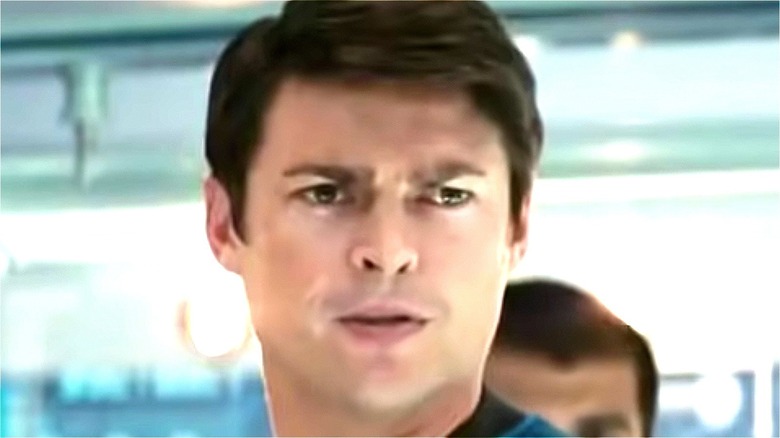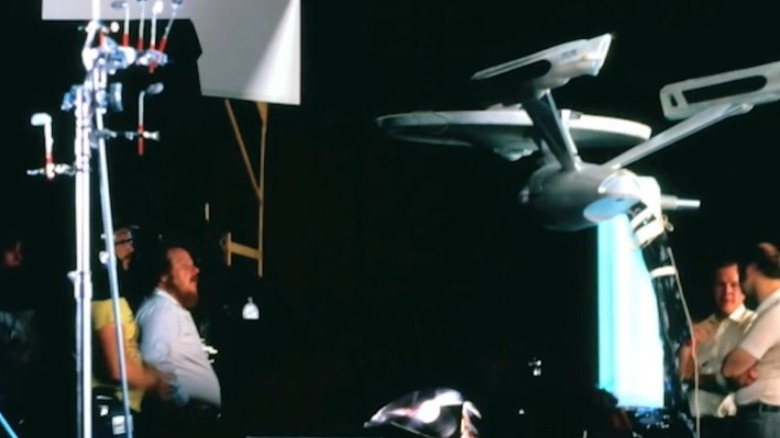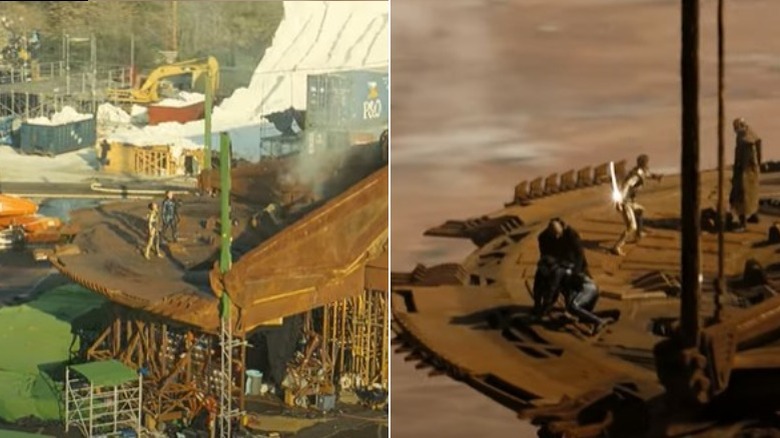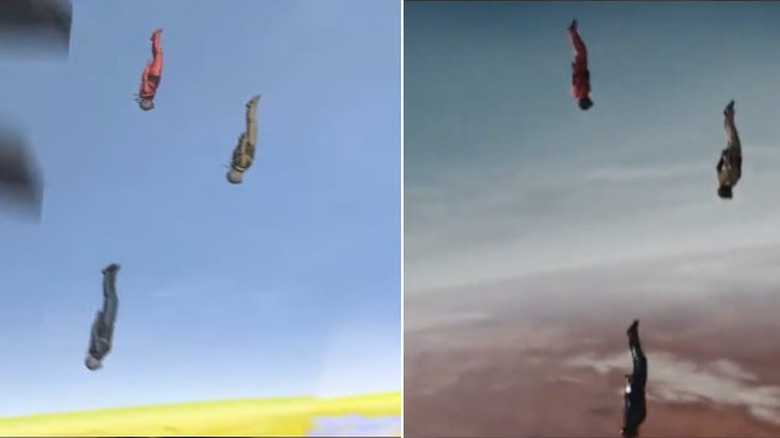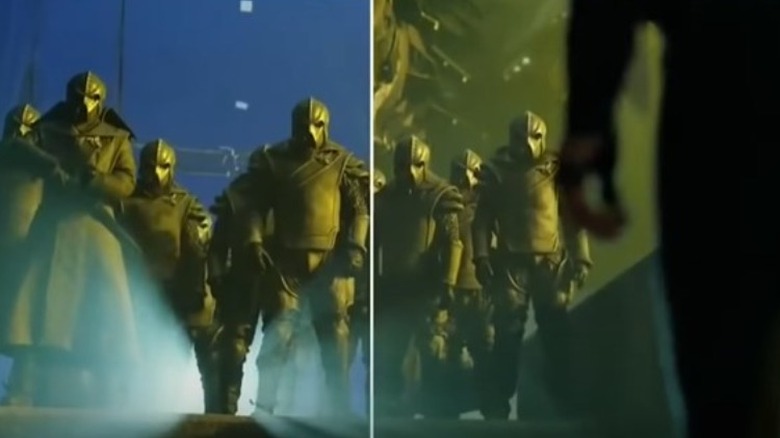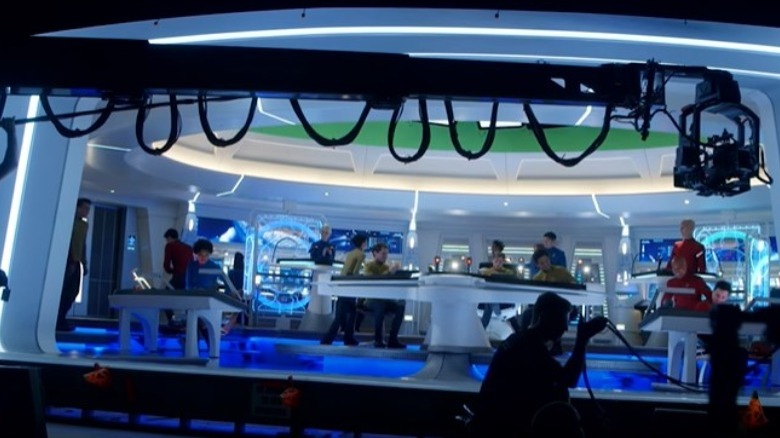What These Star Trek Movies Look Like Without Special Effects
When it comes to iconic film franchises, few have shaped Hollywood and the special effects industry more than "Star Trek" has. From the early days of "Star Trek: The Motion Picture" to J.J. Abrams' reimagined and rebooted run in the 2000s, and then Justin Lin's "Star Trek Beyond" outing in 2016, it's hard to find movies that have done as much for the world of CGI and cinematography, as a whole, than "Star Trek" has.
Over the years, there have been a number of documentaries and inside looks at the movie franchise and cinematic advancements, with most eventually landing on YouTube for a Trekkie's viewing pleasure. Even the original William Shatner-led series has been highlighted for changing the way films and television shows are made. Looking back, it's easy to get lost in all the amazing scenes and digital sorcery. But Looper is here to help. Below, we have compiled some behind-the-scene photos and images of what "Star Trek" movies and scenes would actually look like if they didn't have all those revolutionary special effects.
Star Trek: The Motion Picture
As was the case for most early "Star Trek" projects, detailed models and miniatures were used heavily during the filming of 1979's "Star Trek: The Motion Picture." This includes shots of the iconic Enterprise starship and other galactic vessels as they glide through outer space. Images released by Piercefilm Productions as part of a behind-the-scenes documentary titled "Sense of Scale" ultimately help provide an inside look at what it was like maneuvering and shaping shots for the sci-fi franchise's very first movie.
"This was what everybody wanted," said visual effects specialist Peter Gerard, who worked on the "Star Trek" team. "'Star Wars' was a monster hit as we all know, and suddenly everybody in town wanted blue screen miniature visual effects."
1979's "Star Trek" ultimately helped guide the world of Hollywood effects into the future, with many of its model makers and specialists going on to work on other hit movie projects. Gerard, for example, helped create visuals for such major sci-fi films as "Ghostbusters," "Terminator 2: Judgement Day," "Independence Day," and all of the 1990s Batman movies. However, "Star Trek: The Motion Picture" certainly would not be the last time that a "Star Trek" film helped shape the special effects industry.
Star Trek (2009)
When J.J. Abrams' "Star Trek" reboot came out in 2009, it was basically unlike anything sci-fi fans had ever seen before. Huge, massive sets combined with amazing CGI and the inclusion of practical props and makeup not only gave moviegoers a realistic and stunning viewing experience, it also later earned the film an Oscar nomination for Best Visual Effects and a win for Best Makeup (via IMDb).
"One of the real main approaches of the movie was that we wanted it to feel like you were really in these places ... and part of that is just creating a sort of very tactile space for the actors to work in," explained VFX supervisor Roger Guyett in a behind-the-scenes video for Industrial Light & Magic, which did all the CG work on "Star Trek."
As pointed out by INVERSE, perhaps the biggest and most revolutionary use of special effects in the movie was Abrams' now-iconic commitment to lens flare. The technique had never really been used by filmmakers in the same capacity that it was during "Star Trek," essentially as storytelling device. "Flares give the film a unique flavor of spontaneity and intensity, paradoxically giving the film a documentary-style grittiness, as well as a fanciful, otherworldly, abstract quality," says ILM sequence supervisor Todd Vaziri on his website FXRant (via INVERSE). But while CGI and digital editing were industry-changing musts for "Star Trek," it was still hard to shy away from classic filming techniques and the use of real-life actors and sets, as seen in the next slide.
Star Trek (2009) — Drop Scene
In what was perhaps the most famous scene from 2009's "Star Trek," we see Kirk (Chris Pine), Hikaru Sulu (John Cho), and Chief Engineer Olson (Greg Ellis) plummet out of a drop ship and down onto a plasma drill being used by the villain Nero (Eric Bana) in an attempt to destroy Vulcan, aka the home planet of Spock (Zachary Quinto). While the entire thing looks fake — with a heavy dose of CGI — effects specialists at Industrial Light & Magic say that much of what we see was actually real.
"We actually were hanging guys upside down from a crane at night, and lighting them as though they had a single source light from the sun," explained ILM's Roger Guyett in the behind-the-scenes video from earlier. "And then they enter the atmosphere and they're flying in the equivalent of a similar atmosphere to the Earth, at that point we were combining again different CG approaches with real guys hanging on wire."
Star Trek Into Darkness
When it came time to make 2013's "Star Trek: Into Darkness," J.J. Abrams ultimately decided to take all his techniques and ideas from his first "Star Trek" outing and thrust them into warp drive. Blue screens, green screens, practical effects, intricate costumes and makeup: "Into Darkness" had it all.
"We want to make people feel like they're really there," explained ILM's Roger Guyett in a 2013 interview with FXGuide. "[Abrams] likes things to feel kind of tactile and believable in a fundamental way," Guyett said. "If you look at the kind of choices we have made, we tended to err on what I would call the practical side of things. It's not a concept art version of San Francisco or a city, it's a working version."
For the scenes on the Klingon planet of Kronos, Guyett and the "Into Darkness" team tried to portray an "underwater cave" look to the environment and atmosphere, using both CGI and practical effects. "J.J. really likes to have that tactile interaction that either starts from or results in a tangible close-up of an actor that people don't question," Guyett said. And director Justin Lin made sure to take this approach into the third and final "Star Trek" movie in Abrams' reboot series.
Star Trek Beyond
As with previous "Star Trek" movies, 2016's "Star Trek Beyond" was a perfect culmination of both digital and practical effects, with real-life actors in costume and makeup carrying out their scenes on massive moving sets, which incorporated green screens. The folks at FilmIsNow have provided a behind-the-scenes look at how much of the filmmaking went down in a YouTube video posted on their page.
In terms of being unique and revolutionary, one major thing that "Beyond" ultimately did for "Star Trek" special effects was provide a more scientific approach — or open the door, per se — to what was being done digitally.
"Right from the outset I kind of presented the idea of folding space and gravitational lensing," explained director Justin Lin in an interview with HD Video Pro (via INVERSE). Previous "Star Trek" films had visualized warp speed as being something with a streak-type look. But in "Beyond" Lin and his visuals team decided to go with a "folding space effect" with a "warp bubble" appearance, which was also used in the making of Christopher Nolan's "Interstellar." Double Negative, the effects studio behind the 2014 sci-fi epic, was in charge of all the digital warp speed work in "Beyond."
